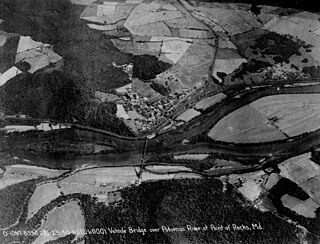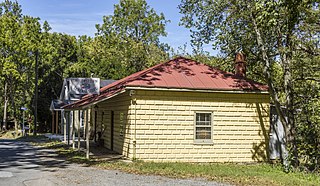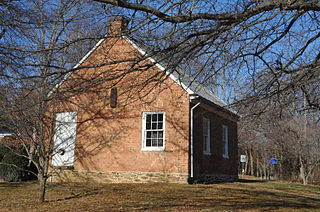
Hillsboro is a rural town in Loudoun County, Virginia, United States. The population was 114 at the 2020 census.

Point of Rocks is an unincorporated community and census-designated place (CDP) in Frederick County, Maryland. As of the 2010 census, it had a population of 1,466.
Unison is an unincorporated community village in Loudoun County, Virginia. It is located approximately five miles from Middleburg in the Loudoun Valley close to the Fauquier County border.

Aldie is an unincorporated community and census-designated place (CDP) located between Chantilly and Middleburg in Loudoun County, Virginia, United States. The historic village of Aldie is located on the John Mosby Highway in a gap between the Catoctin Mountains and Bull Run Mountains, through which the Little River flows. Aldie traditionally serves as the gateway to the Loudoun Valley and beyond.
Lincoln is a historic unincorporated village in the Loudoun Valley of Loudoun County, Virginia, located approximately 1.5 miles (2.4 km) south of Purcellville. It was established as the community of Goose Creek during the 1750s by Quaker settlers and renamed "Lincoln" for the president of the same name, shortly after his election in 1860.
Taylorstown is a small community in Loudoun County, Virginia, built on the banks of Catoctin Creek and the surrounding hillside, about two miles (3 km) south of the Potomac River. First settled in 1734, it holds two of the oldest standing houses in Loudoun County, "Hunting Hill" and "Foxton Cottage", directly across the Catoctin Creek from each other.

Buildings, sites, districts, and objects in Virginia listed on the National Register of Historic Places:

Green Springs National Historic Landmark District is a national historic district in Louisa County, Virginia noted for its concentration of fine rural manor houses and related buildings in an intact agricultural landscape. The district comprises 14,000 acres (5,700 ha) of fertile land, contrasting with the more typical poor soil and scrub pinelands surrounding it.
The Catoctin Valley is a small valley, geographically and culturally associated with the larger Loudoun Valley in Loudoun County, Virginia.

This is a list of the National Register of Historic Places listings in Loudoun County, Virginia.

Temple Hall is an early 19th-century Federal-style mansion and working farm near the Potomac River north of Leesburg in Loudoun County, Virginia.

The Leesburg Historic District in Leesburg, Virginia is a historic district that includes Classical Revival, Greek Revival, and Georgian architecture and dates back to 1757. It was listed on the National Register of Historic Places in 1970 and its boundaries were increased in 2002.

Carlheim is a mansion located in the northeast part of Leesburg, Virginia. It was constructed in about 1872 for Pennsylvania industrialist Charles R. Paxton (1816–1889) and his wife Rachel who continued to live there until her death in December 1921. When constructed, it sat on over 760 acres (3.1 km2) roughly bounded on the north end by the Red Rock Wilderness Overlook Regional Park, the Ball's Bluff Battlefield and the Potomac River. In accordance with Mrs. Paxton's will, the buildings and 50 surrounding acres were preserved and organized into a charitable trust to benefit "needy children."

The Goose Creek Meeting House Complex is a Quaker worship center, with an original 1765 Meeting House, an 1817 meeting house, a burying ground, and the Oakdale schoolhouse in the village of Lincoln, Virginia. The complex is on the site of the original log meeting house, built about 1750. The 1765 meeting house is a one-story stone building, and was converted to a residence after the construction of the 1817 meeting house.

The Arcola Slave Quarters were built circa 1800 on the grounds of the Lewis plantation at Arcola in Loudoun County, Virginia. The plantation house was replaced by a different house in the 1930s on the original foundation, but the slave quarters remain. The stone structure is a double-pen building built into an embankment downhill from the main house. The western end is older, with two connecting rooms and a cellar, accessible through a hole in the floor. The eastern end consists of two rooms, connected to the original wing by a breezeway. Each block has a central chimney with two hearths. The walls are stone rubble construction with timber roof construction. A loft, probably a later addition, has been created in the attic space. The floors are dirt, except for the room over the cellar, which is wood. The roof is asphalt roll roofing over plywood, but traces of the older wood shake roof remain. There are several window openings which do not appear to have been glazed, but rather shuttered.

The Catoctin Creek Bridge crosses over Catoctin Creek in Loudoun County, Virginia.

The Taylorstown Historic District comprises the historic core of Taylorstown, Virginia. The community and the historic district are centered on the Taylorstown Mill, a two-story stone structure on the banks of Catoctin Creek. Up the hill from the mill is Hunting Hill, a house built in 1737 for the mill's owner. The district also includes a store built in 1800, adjoined by the 1904 Mann's Store, with the 1900 Mann house across the street.

The Goose Creek Historic District is a rural landscape in the Goose Creek valley of Loudoun County, Virginia. The district covers about 10,000 acres (4,000 ha) south of Hamilton and Purcellville and includes the village of Lincoln. The majority of the district is farmland, with areas of forest along Hogback Mountain. The area was settled by Quakers in the mid-18th century, represented by simple houses and the Goose Creek Meetinghouse Complex in Lincoln, separately listed on the National Register of Historic Places. About 270 buildings lie within the district. The district includes 44 stone buildings, reflecting the popularity of this material in the 18th and 19th centuries in this area. Many houses have outbuildings and barns built in a manner complementary to the dwellings. By the mid-19th century, materials turned to brick, with the Glebe of Shelburne Parish an NRHP-listed example of a brick Federal style house, as well as the Israel Janney House.

The Bluemont Historic District comprises the historic core of Bluemont, Virginia. The town is located on the eastern side of Snickers Gap, with the majority of the district fronting on the Snickersville Turnpike, also designated Virginia State Route 734. The district includes 43 buildings, of which 36 are houses, five are commercial structure, a church and a community center. The oldest structure in Bluemont is Clayton Hall (1797), a large stone house. The Amos Clayton farm was located at the junction of Routes 734 and 760, now in the center of town. Relatively few pre-Civil War structures remain in Bluemont. Apart from Clayton Hall, the most significant is the Bluemont Methodist Church.

Janney House, also known as Morrison House and Janney Hill, is a historic home located at Hamilton, Loudoun County, Virginia. It was built in 1876, and is a 2+1⁄2-story, five-bay, wood frame I-house in the Late Victorian style. It sits on a stone foundation and has a standing seam metal side gable roof. It features a one-story, wraparound porch. Also on the property is a contributing combination garage and stable building.
























